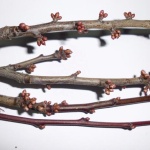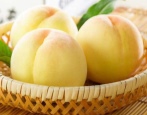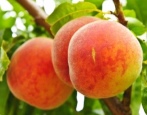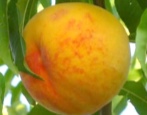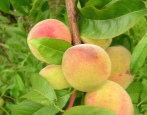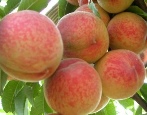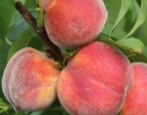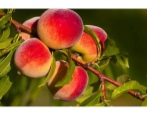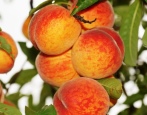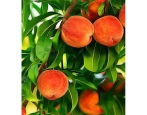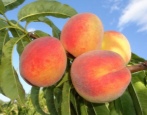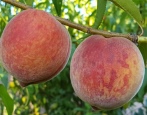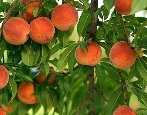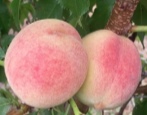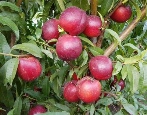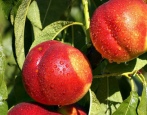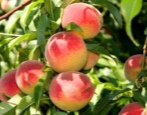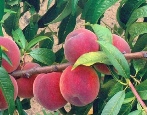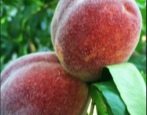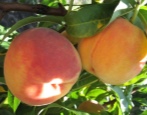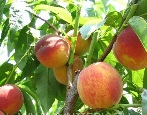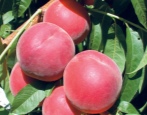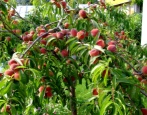
- Authors: USA
- Growth type: medium-sized
- Ripening period: mid-late
- Self-fertility: self-fertile
- Appointment: for fresh consumption, for canning
- Yield: high
- Marketability: high
- Transportability: high
- Early maturity: comes into fruiting for 2 years
- Bone size: small
Peach Saturn can be a good filling for many garden plots. However, for this purpose, it is necessary to thoroughly study its features and nuances of cultivation. It is advisable to start with a general botanical characteristic.
Description of the variety
Peaches such as Saturn originated in the United States; not listed in the state register of the Russian Federation. This culture is one of the fig trees. Its medium-sized trunks reach a height of 3-4 m. The crown resembles a ball in shape, but at the same time it is not overly dense. It is very wide and spreading. Saturn's leaves are slightly pubescent.
They are lanceolate. The lower edge of the foliage is gray. Above, the classic green color is typical. The flowers of this variety have a pale pink hue. Tall stamens are typical for them.
Fruit characteristics
The large drupes of Saturn are attractive yellow by default. Raspberry blush covers a large area, and appears on almost the entire surface of the fruit. The drupe itself is similar in shape to a flat disc. Its mass ranges from 110 to 140 g, pubescence is present, but it is not too pronounced. A small bone is well freed from the pulp, and the shelf life of the crop in the refrigerator reaches 12 days.
Taste qualities
The creamy pulp of such fruits is juicy. It has a typically high fiber content. In general, Saturn's taste is sweet and not satisfactory. Based on the results of the tasting examination, he was awarded a score of 4.9 points.
Ripening and fruiting
It is necessary to expect the appearance of the first drupes in the second year of development. The first flowers of the season are formed in April. It is believed to be a mid-late variety. The approximate time for fruit formation is in the last 5-6 days of July. However, it is influenced by both agricultural technology and the weather, therefore there can be no great accuracy here.
Yield
In terms of productivity, such trees can compete with other varieties of peach. On average, this figure reaches 49 kg per 1 tree. Importantly, the harvested crop will meet all the criteria for marketability.
Self-fertility and the need for pollinators
Peach Saturn is self-fertile. There is little need for additional pollinators. However, their use is practiced by all experienced gardeners as a way to achieve a good harvest.
Growing and care
Intensive watering is carried out only during dry periods. During normal weather, it is recommended to practice it strictly as needed. The plant will have to be pruned twice during the season. Saturn and other fig varieties are planted according to the same system as classic peaches. In the south, planting is possible both in the spring and in the autumn months, and if the seedlings are kept in containers with a closed root system, then throughout the summer as well.
It is recommended to prepare the pits in advance. Trunk circles after disembarkation should be mulched. In autumn, organic or nitrogenous fertilizing is not added to the pit. Before buds bloom, the plant must be treated with Bordeaux liquid or copper sulfate.The same protective treatment is carried out after the completion of the leaf fall.
Other care measures:
treatment with "Karbofos" and other drugs when pests appear;
sanitary pruning of broken branches (using garden varnish) 4
digging the earth in the trunk circle;
applying lime to the trunk (combined with cleaning the bark).
At the time of flowering, fertilizing with Azophos is required. With the active growth of ovaries, an infusion of ash is added by the foliar method. When the buds bloom, ammonium nitrate is added under the root. In the spring, under each tree, urea is also laid along with ammonium nitrate (but it should be less than the main fertilizer). In the autumn, potash-phosphorus fertilizers are used.
During autumn digging, manure is introduced. Care must be taken to ensure that it does not harm the plant due to its chemical activity. Pruning is carried out only in warm, dry weather. Basically, the crown is formed in the form of a bowl - this is the most practical and beautiful solution. You can mulch Saturn before the onset of winter with humus, grass or compost.
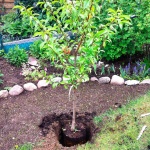
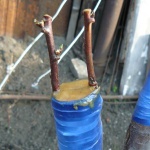
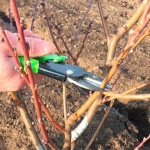
Frost resistance and the need for shelter
In general, such a peach is declared as a frost-resistant plant. But one must understand that this indicator is relative for a culture of southern origin. In any difficult winter, you will definitely need shelter.
Disease and pest resistance
Good resistance to curl is officially declared. Bacterial infections can harm Saturn, and special attention must be paid to their prevention. The root nematode is not terrible for such a plant. Often there are complaints about eating by the moth.
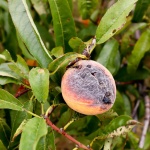
Requirements for soil and climatic conditions
Landing on the southern sides of the plots is recommended. They must be protected from normal winds and drafts. Drought tolerance is not described, but for indirect reasons in the descriptions it is clear that it is quite high.
